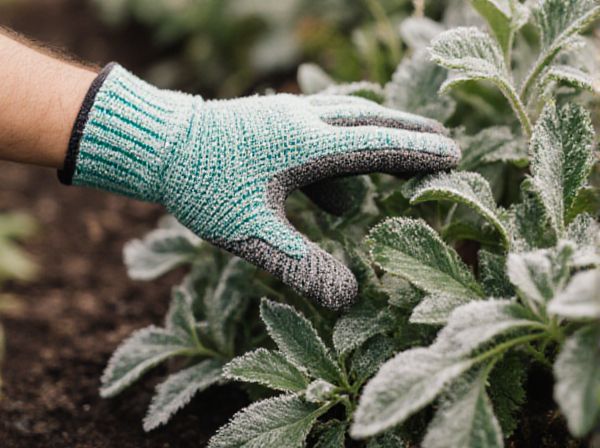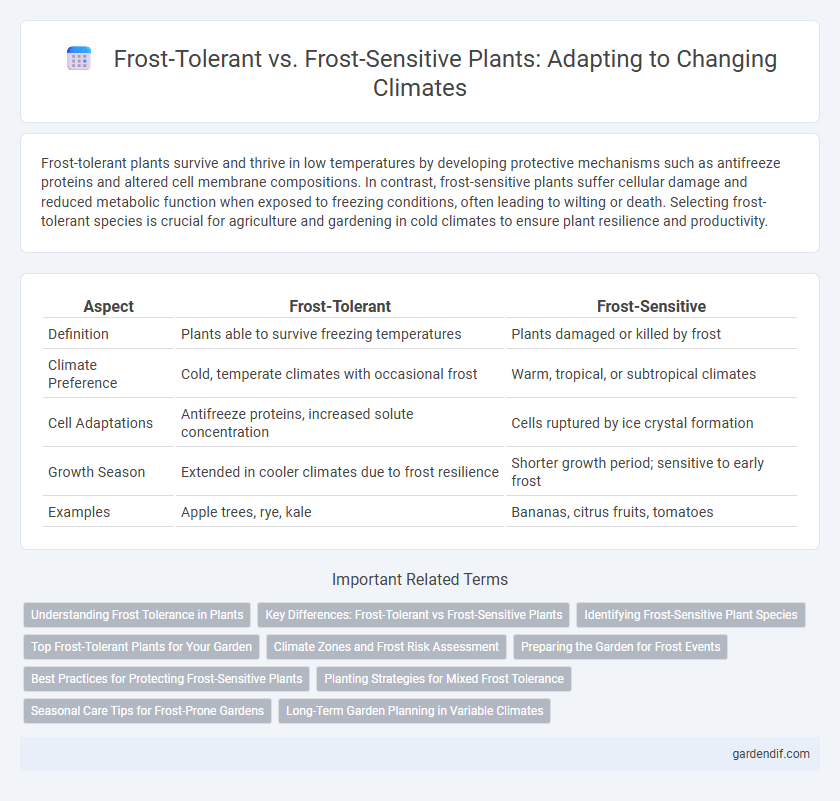
Frost-tolerant vs Frost-sensitive Illustration
Frost-tolerant plants survive and thrive in low temperatures by developing protective mechanisms such as antifreeze proteins and altered cell membrane compositions. In contrast, frost-sensitive plants suffer cellular damage and reduced metabolic function when exposed to freezing conditions, often leading to wilting or death. Selecting frost-tolerant species is crucial for agriculture and gardening in cold climates to ensure plant resilience and productivity.
Table of Comparison
| Aspect | Frost-Tolerant | Frost-Sensitive |
|---|---|---|
| Definition | Plants able to survive freezing temperatures | Plants damaged or killed by frost |
| Climate Preference | Cold, temperate climates with occasional frost | Warm, tropical, or subtropical climates |
| Cell Adaptations | Antifreeze proteins, increased solute concentration | Cells ruptured by ice crystal formation |
| Growth Season | Extended in cooler climates due to frost resilience | Shorter growth period; sensitive to early frost |
| Examples | Apple trees, rye, kale | Bananas, citrus fruits, tomatoes |
Understanding Frost Tolerance in Plants
Frost-tolerant plants possess cellular mechanisms that prevent ice crystal formation, enabling them to survive subzero temperatures by stabilizing cell membranes and producing antifreeze proteins. In contrast, frost-sensitive plants lack these adaptations, causing cellular damage and impaired physiological functions upon exposure to frost. Understanding the genetic and biochemical basis of frost tolerance enhances crop selection and breeding strategies for climate resilience.
Key Differences: Frost-Tolerant vs Frost-Sensitive Plants
Frost-tolerant plants possess cellular structures and antifreeze proteins that enable them to survive temperatures below freezing by minimizing ice crystal formation within their tissues. In contrast, frost-sensitive plants lack these adaptations and suffer cellular damage or death when exposed to frost due to intracellular ice development. Understanding these key physiological differences guides agricultural practices and plant selection in climates prone to sudden temperature drops.
Identifying Frost-Sensitive Plant Species
Frost-sensitive plant species such as tomatoes, peppers, and basil exhibit cellular damage when exposed to temperatures below 32degF (0degC), leading to wilting and tissue necrosis. Identifying these plants involves monitoring early frost alerts and understanding their vulnerability during the critical growth phases, particularly in spring and fall. Employing frost protection strategies, like using frost cloths or relocating potted plants indoors, is essential to prevent irreversible damage to frost-sensitive crops.
Top Frost-Tolerant Plants for Your Garden
Top frost-tolerant plants for your garden include hardy species like hellebores, sedums, and ornamental cabbages, which can survive temperatures as low as -20degF (-29degC). These plants have adapted mechanisms such as antifreeze proteins and deep dormancy phases to withstand frost damage. Choosing frost-tolerant varieties ensures extended garden beauty and reduces winter plant loss compared to frost-sensitive species like impatiens or basil.
Climate Zones and Frost Risk Assessment
Frost-tolerant plants thrive in climate zones characterized by frequent sub-zero temperatures, such as temperate and continental regions, where frost risk assessment is critical for agricultural planning. Frost-sensitive species require warmer, frost-free zones, typically found in tropical and subtropical climates, necessitating detailed microclimate analysis to mitigate frost damage. Accurate frost risk assessment integrates historical climate data, local topography, and weather forecasting to guide crop selection and protect vulnerable vegetation.
Preparing the Garden for Frost Events
Frost-tolerant plants such as kale, pansies, and sage require minimal protection during cold snaps compared to frost-sensitive species like tomatoes and petunias, which need thorough covering or relocation. Gardeners should use mulch, frost cloths, and windbreaks to shield vulnerable plants, ensuring roots stay insulated and foliage remains unharmed. Monitoring local frost forecasts and timing protective measures before the temperature drops can significantly reduce damage and improve plant survival rates.
Best Practices for Protecting Frost-Sensitive Plants
Frost-sensitive plants require focused protection strategies such as using frost cloths, mulching, and placing them in sheltered locations to mitigate damage from low temperatures. Employing watering techniques during cold nights helps maintain soil warmth, reducing frost impact on vulnerable tissues. Selecting frost-tolerant varieties for outdoor planting zones also enhances garden resilience against sudden temperature drops.
Planting Strategies for Mixed Frost Tolerance
Planting strategies for mixed frost tolerance involve grouping frost-tolerant species with frost-sensitive plants to create microclimates that reduce exposure to cold damage. Using frost-tolerant plants as windbreaks or shelter belts can protect more vulnerable species from frost by minimizing wind chill and retaining heat. Strategic layering and site selection leveraging sunlight exposure and drainage further enhance plant survival during frost events.
Seasonal Care Tips for Frost-Prone Gardens
Frost-tolerant plants like hellebores and sedum withstand low temperatures and require minimal protection, whereas frost-sensitive species such as impatiens and tender herbs need extra precautions to survive. Insulating soil with mulch and using frost cloths during cold snaps help preserve root warmth and prevent leaf damage in frost-prone gardens. Timing seasonal pruning to avoid stimulating new growth in late autumn reduces vulnerability to frost-related stress and enhances plant resilience.
Long-Term Garden Planning in Variable Climates
Frost-tolerant plants, such as rosemary and hellebores, are essential for long-term garden planning in variable climates because they can survive sudden temperature drops and extend the growing season. In contrast, frost-sensitive species like tomatoes and basil require protective measures or seasonal replacement to prevent damage from unexpected frosts. Prioritizing frost-tolerant varieties increases garden resilience and reduces maintenance costs in regions with unpredictable winter conditions.
Frost-tolerant vs Frost-sensitive Infographic

 gardendif.com
gardendif.com